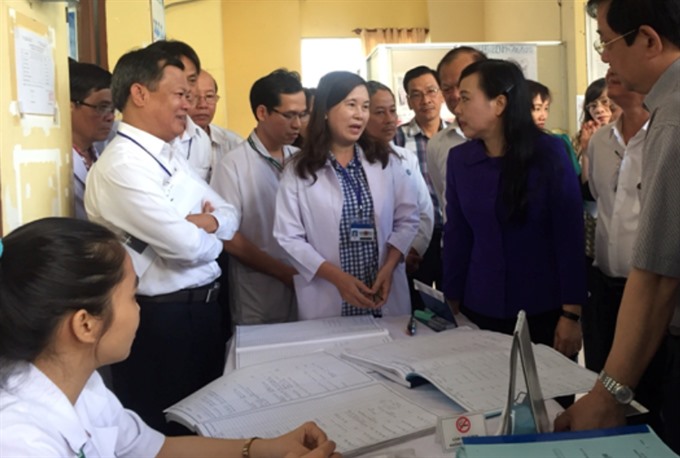 Society
Society

The Ministry of Health will soon spell out what medicines and medical techniques should be used by ward- and commune-level health centres around the country to make the family medicine model more efficient and reassure patients.
 |
| Minister of Health Nguyễn Thị Kim Tiến visits the Tân Thành Ward health centre in HCM City’s Tân Phú District, where the family medicine model is being implemented. — Source of www.medinet.hochiminh.gov.vn |
HCM CITY — The Ministry of Health will soon spell out what medicines and medical techniques should be used by ward- and commune-level health centres around the country to make the family medicine model more efficient and reassure patients.
It hopes to adopt the model in 80 per cent of provinces and cities.
Minister of Health Nguyễn Thị Kim Tiến said the adoption of the family medicine model could help ensure patients do not go to district or higher level hospitals for treatment of minor ailments.
Patients often do this because grassroots-level health facilities do not provide sufficient care.
“If the model is efficient it could help reduce the overcrowding at high-level health facilities, which also causes a risk of transmission.”
Grassroots health centres will also benefit from the new move.
In HCM City, 191 out of 319 ward- and commune-level health centres have adopted the family medicine model starting in 2013.
Speaking at a meeting on family medicine in HCM City on Monday, Dr Lưu Thị Thanh Huyền, deputy head of the city’s Social Insurance Agency, said 70 centres in the city failed to get even one patient last year.
Nguyễn Thanh Trang, head of the Tân Bình District’s Preventive Medicine Centre, which manages the district’s health centres, said 10 of them had seen the family medicine model fail.
“Patients do not come to these medical facilities for many different reasons, one of them being that patients did come but there was no doctor to treat them.”
Lê Văn Thể, head of the District 1’s Preventive Health Centre, said the family medicine model was adopted at the Cô Giang Ward Health Centre in 2013.
“In the beginning the centre attracted a large number of patients, most of them insured, but now few come because insured patients have no cover for ultrasound and blood tests," he said.
Moreover, "medicines provided at the centre are not similar to the ones provided at district-level hospitals, making patients fear they are not of good quality," he said.
So insured patients went straight to district-level hospitals, he said.
According to Huyền of the city’s Social Insurance Agency, it is not right to say that health insurance does not cover ultrasound and blood tests at ward- and commune-level health centres.
But the fact is that at several centres, the machines are installed by medical equipment suppliers, who share the fees that patients pay for testing, and not the city’s Department of Health, she revealed.
Tiến said doctors at district hospitals should provide technical assistance to ward- and commune-level health centres, like Thủ Đức District Hospital does.
The hospital’s doctors take turns to work at lower level health centres to train and improve their professional skills.
The hospital and these centres share health data of insured patients, according to Dr Nguyễn Minh Quân, the former’s head.
"Thus, doctors at the hospital know about a patient’s health status when a centre transfers them to the hospital for further treatment", he said.
"The hospital has also provided these centres with equipment."
"The latter function as the hospital’s satellite clinics, and attract a large of number of patients," he said.
For instance, the Bình Chiểu Ward health centre, which has adopted the family medicine model, got around 80 insured patients every day, he added. —VNS




